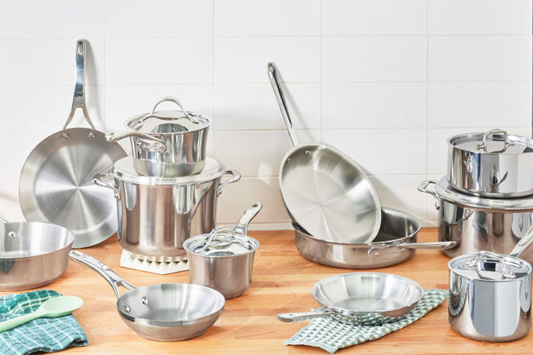Imagine this: you’re scrolling through a kitchenware catalog, eyeing the various pots and pans, trying to decide which one would be perfect for your kitchen. Should you go with the ever-popular stainless steel, or would hard-anodized cookware be a better fit? If you’ve found yourself standing in the kitchen aisle or browsing online reviews wondering, “Which is better: hard anodized or stainless steel?” you’re not alone.
Choosing between these two types of cookware can feel a bit overwhelming. Both have their unique benefits, and each one promises a great cooking experience. Stainless steel is durable, professional-looking, and versatile, while hard-anodized cookware offers a lighter, non-stick option that’s easier to clean. But what’s right for one person may not be ideal for someone else, so let’s dive into these two types of cookware and break down their differences, benefits, and the scenarios in which each might shine the brightest.
Stainless Steel vs Hard Anodized Cookware: Differences Contrast
Before choosing between hard anodized or stainless steel, it’s essential to understand the fundamental differences in their material and performance.
What is Stainless Steel Cookware?

Stainless steel cookware is a popular choice in many kitchens, from professional restaurants to home setups. Made from an alloy of metals, including iron, carbon, and chromium, stainless steel has earned a reputation for its durability and resistance to rust and corrosion. This metal combination makes it a fantastic option for people looking for cookware that can withstand high temperatures and heavy use.
One unique characteristic of stainless steel cookware is its ability to handle acidic foods without reacting or affecting the taste, thanks to its non-reactive nature. High-quality stainless steel pots and pans often come with an aluminum or copper core, which helps to improve heat distribution. This core helps the cookware heat evenly, reducing hot spots and making it ideal for a wide range of cooking techniques, from searing to sautéing and boiling.
What is Hard-Anodized Cookware?

Hard-anodized cookware is made from aluminum that’s been treated through an electrochemical process, giving it a hard, durable surface. This treatment makes the aluminum surface non-reactive and scratch-resistant, meaning it can withstand the rigors of everyday cooking. It’s also naturally non-stick, which is one of the main reasons people choose hard-anodized cookware—it makes cooking and cleaning a breeze.
The hard-anodizing process not only strengthens the aluminum but also provides better heat conductivity, allowing the pan to heat up quickly and evenly. This quality makes hard-anodized pans great for everyday cooking tasks, like frying, simmering, or boiling. Many hard-anodized pans also come with a non-stick coating, which reduces the need for excessive oil and makes them easy to clean.
With these structural differences, let’s now look at how these materials stack up against each other in terms of performance, durability, and ease of maintenance.
Stainless Steel vs Hard Anodized Cookware: Key Differences
To make it easier to decide between stainless cookware vs hard anodized, let’s break down some core differences in performance, cleaning, and overall durability. Here’s a look at the factors that could influence your decision.
Cooking Performance and Heat Distribution
One of the main reasons people choose stainless steel cookware is for its durability and ability to handle high heat. Stainless steel cookware is ideal for browning, searing, and deglazing—techniques that benefit from high heat and the ability to create a fond (those little browned bits on the bottom of the pan). However, pure stainless steel isn’t the best heat conductor, so high-quality stainless steel pans often come with an aluminum or copper core to improve heat distribution.
On the other hand, hard-anodized cookware, being made of treated aluminum, naturally heats up quickly and evenly. Aluminum is an excellent heat conductor, and the anodized process gives it the durability it needs to withstand daily use. This even heat distribution makes hard-anodized cookware a fantastic choice for tasks like frying or simmering, where maintaining consistent temperature is essential.
If you’re someone who likes quick and even heat for everyday cooking, hard-anodized pans might be more appealing. However, if you love using high heat and building flavors through searing and deglazing, stainless steel could be a better choice.
Non-stick Qualities and Ease of Use
Another significant difference between hard anodized or stainless steel is the non-stick factor. Stainless steel, while durable, is not naturally non-stick. Cooking with stainless steel often requires oil or butter to prevent food from sticking, which can add flavor but may require extra cleanup.
Hard-anodized cookware usually comes with a non-stick coating, which means less need for added fats. The non-stick surface also makes it easier to flip, turn, and remove foods without leaving pieces behind, making it especially useful for delicate foods like eggs or fish. For people who prefer low-fat cooking or want an easy-to-clean option, hard-anodized might be the better choice.
Durability and Lifespan
When comparing stainless cookware vs hard anodized in terms of durability, both materials hold up well, but there are differences. Stainless steel is extremely durable and resistant to scratching, denting, or warping. Many high-quality stainless steel pans can last a lifetime if properly cared for. It’s also non-reactive, so it doesn’t interact with acidic foods like tomatoes, which helps preserve flavor.
Hard-anodized aluminum is also very durable, but it’s essential to note that the non-stick coating can wear down over time, especially if metal utensils are used. However, with proper care (such as using wooden or silicone utensils and hand-washing), hard-anodized cookware can last several years.
Contrast Table
| Feature | Stainless Steel Cookware | Hard-Anodized Cookware |
| Material Composition | Alloy of iron, carbon, and chromium; often with an aluminum or copper core for better heat conductivity | Aluminum that’s been electrochemically treated for durability |
| Heat Distribution | Good, especially when an aluminum or copper core is included | Excellent, thanks to aluminum’s high heat conductivity |
| Cooking Performance | Great for high-heat methods like searing, browning, and deglazing | Best for low to medium-heat tasks like frying and simmering |
| Non-Stick Properties | Not naturally non-stick; requires oil or butter | Naturally non-stick due to anodizing and often has additional non-stick coating |
| Durability | Extremely durable, scratch and dent-resistant. | Durable, but non-stick coating can wear down over time |
| Maintenance | Hand-washing recommended; may require occasional polishing | Hand-washing recommended; easy to clean but avoid metal utensils |
| Best Cooking Styles | Ideal for high-heat cooking and acidic dishes | Perfect for everyday, low-fat cooking and delicate foods like fish or eggs |
| Cost | Generally more expensive for high-quality, layered versions | Usually moderately priced, with a range of affordable options |
| Lifespan | Can last a lifetime with proper care | Lasts several years, but lifespan may vary based on non-stick coating durability |
Applications of Stainless Steel and Hard-Anodized Cookware
Both stainless steel and hard-anodized cookware have unique applications that make them ideal for different types of cooking. Let’s look at how they might fit into various cooking styles and kitchen setups.
Ideal Uses for Stainless Steel Cookware
Stainless steel is versatile enough to handle a wide range of cooking techniques, from searing meats to sautéing vegetables. The cookware can go from stovetop to oven without any issues, making it ideal for recipes that require finishing in the oven. Additionally, since stainless steel is non-reactive, it works well with acidic foods, like tomato-based sauces or citrus-marinated dishes, without altering their flavors.
Stainless steel’s resilience also makes it a favorite in professional kitchens, where cookware is subjected to high heat and frequent use. If you often find yourself cooking large meals or using high-heat methods, stainless steel might be your best bet for lasting performance.
Ideal Uses for Hard-Anodized Cookware
Hard-anodized cookware is a go-to option for everyday cooking due to its non-stick properties and even heat distribution. It’s perfect for meals that require a quick, even cook, such as stir-fries, pancakes, or omelets. Additionally, since hard-anodized cookware doesn’t require much oil for cooking, it’s ideal for those looking to prepare lower-fat meals.
This type of cookware is also user-friendly and easy to clean, making it well-suited for busy households or individuals who prefer low-maintenance kitchen tools. With a simple rinse and a gentle scrub, you can keep hard-anodized cookware looking good as new for years.
Best Practices for Using and Caring for Your Cookware
Whether you choose hard anodized or stainless steel, caring for your cookware properly can extend its lifespan and keep it performing well. Here are some tips for each type.
Caring for Stainless Steel Cookware
- Preheat Properly: Allow your pan to preheat before adding oil or food. This helps prevent sticking and allows for even cooking.
- Avoid Harsh Cleaners: Stainless steel can scratch if harsh abrasives are used. Opt for mild soap and water, or use a stainless steel cleaner for tough spots.
- Polish Regularly: Over time, stainless steel can lose its shine. Polishing occasionally with a stainless steel cleaner will keep it looking fresh.
Caring for Hard-Anodized Cookware
- Use Non-Metal Utensils: To prevent scratching, avoid metal utensils. Instead, use silicone, wood, or plastic tools.
- Hand Wash Recommended: Although some hard-anodized cookware is labeled dishwasher-safe, hand washing is generally recommended to extend the life of the non-stick surface.
- Avoid Cooking Sprays: These sprays can create a sticky residue that’s hard to clean. Stick to oils or butter if you need added fats.
Conclusion
Deciding between stainless cookware vs hard anodized depends on what you’re looking for in your cooking experience. Stainless steel is a fantastic, long-lasting option for those who enjoy versatile, high-heat cooking. It’s durable, looks great in the kitchen, and is a go-to choice for professional chefs.
Hard-anodized cookware, on the other hand, appeals to those seeking convenience, non-stick benefits, and quick cleanup. It’s perfect for daily meals, low-fat cooking, and anyone who appreciates an easy-to-care-for kitchen essential.
By weighing your cooking preferences, maintenance style, and what you value most in your cookware, you’ll be able to choose the right option for you. Whether you go with the shine of stainless steel or the non-stick ease of hard-anodized, you’re one step closer to making your kitchen a place you love to cook in.




